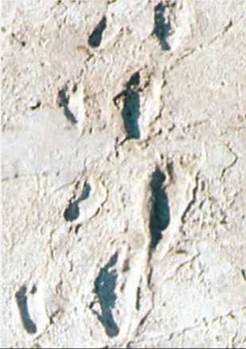THE LIVING WORLD
Unit Five. Evolution of Animal Life
21. How Humans Evolved
Five to 10 million years ago, the world’s climate began to get cooler, and the great forests of Africa were largely replaced with savannas and open woodland. In response to these changes, a new kind of ape was evolving, one that was bipedal. These new apes are classified as hominids—that is, of the human line.
The major groups of hominids include three to seven species of the genus Homo (depending how you classify them), seven species of the older, smaller-brained genus Australopithecus, and several even older lineages. In every case where the fossils allow a determination to be made, the hominids are bipedal, walking upright. Bipedal locomotion, while not unique to humans (figure 21.3), seems to have set the genus Homo on a new evolutionary path.

Figure 21.3. Walking upright has evolved many times among vertebrates.
(a) T. rex (reptiles), (b) king penguin (birds), (c) ostrich (birds), (d) kangaroo (mammals), (e) Australopithecus (mammals).
The Origins of Bipedalism
A treasure trove of fossils unearthed in Africa demonstrate that bipedalism extended back 4 million years ago; knee joints, pelvis, and leg bones all exhibit the hallmarks of an upright stance. Substantial brain expansion, on the other hand, did not appear until roughly 2 million years ago. In hominid evolution, upright walking clearly preceded large brains.
Remarkable evidence that early hominids were bipedal is a set of some 69 hominid footprints found at Laetoli, East Africa (figure 21.4). Two individuals, one larger than the other, walked side by side for 27 meters, their footprints preserved in 3.7-million-year-old volcanic ash!

Figure 21.4. The Laetoli footprints.
These Australopithecus footprints are 3.7 million years old. The impression in the ash reveals a strong heelstrike and a deep indentation made by the big toe, much as you might make in sand when pushing off to take a step. Importantly, the big toe is not splayed out to the side as in a monkey or ape—the footprints were clearly made by a hominid.
Key Learning Outcome 21.3. The evolution of bipedalism—walking upright—marks the beginning of hominid evolution.